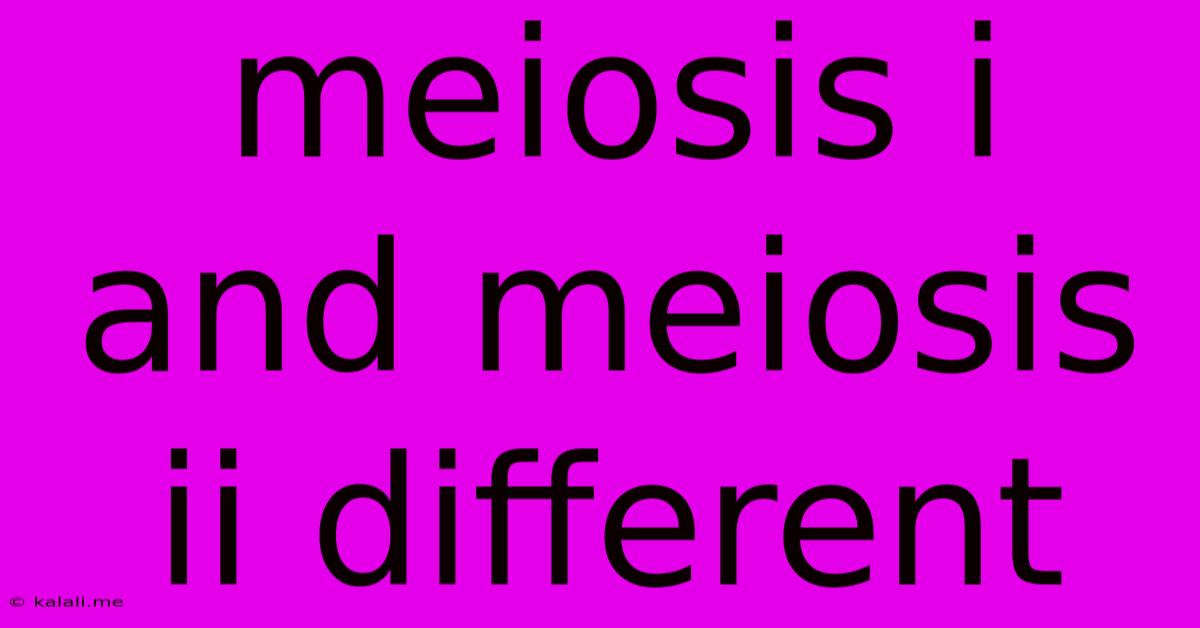Meiosis I And Meiosis Ii Different
Kalali
May 08, 2025 · 3 min read

Table of Contents
Meiosis I vs. Meiosis II: Understanding the Key Differences
Meiosis is a specialized type of cell division that reduces the chromosome number by half, creating four haploid cells from a single diploid cell. This process is crucial for sexual reproduction, ensuring genetic diversity in offspring. Meiosis is divided into two main phases: Meiosis I and Meiosis II. While both phases involve similar stages (prophase, metaphase, anaphase, telophase), there are significant differences that distinguish them and contribute to the overall reduction in chromosome number. This article will delve into these key distinctions.
Meta Description: Discover the crucial differences between Meiosis I and Meiosis II. Understand how these two phases contribute to the reduction of chromosome number and the creation of genetically diverse gametes. Learn about homologous chromosome separation, sister chromatid separation, and the resulting haploid cells.
Meiosis I: The Reductional Division
Meiosis I is characterized by the separation of homologous chromosomes. This is what makes it the "reductional division" – reducing the chromosome number from diploid (2n) to haploid (n). Let's break down the key differences within this phase:
-
Prophase I: This is the longest and most complex phase. It's here that crossing over, a crucial process for genetic recombination, occurs. Homologous chromosomes pair up, forming tetrads, and exchange segments of DNA. This exchange shuffles genetic material, creating new combinations of alleles and contributing significantly to genetic variation.
-
Metaphase I: Homologous chromosome pairs align at the metaphase plate, independent of each other. This independent assortment is another significant contributor to genetic diversity. The orientation of each homologous pair is random, leading to different combinations of maternal and paternal chromosomes in the resulting daughter cells.
-
Anaphase I: Homologous chromosomes separate and move to opposite poles of the cell. Crucially, sister chromatids remain attached at the centromere. This is a key difference from Anaphase II.
-
Telophase I and Cytokinesis: The cell divides, resulting in two haploid daughter cells, each with half the number of chromosomes as the original diploid cell. However, each chromosome still consists of two sister chromatids.
Meiosis II: The Equational Division
Meiosis II is more similar to a typical mitotic division. Here, sister chromatids are separated, resulting in four haploid daughter cells, each genetically unique.
-
Prophase II: The chromosomes condense again if they decondensed during telophase I. The nuclear envelope breaks down (if it reformed during telophase I).
-
Metaphase II: Chromosomes (each consisting of two sister chromatids) align at the metaphase plate.
-
Anaphase II: Sister chromatids finally separate and move towards opposite poles. This is the defining difference from Anaphase I.
-
Telophase II and Cytokinesis: The cell divides, resulting in four haploid daughter cells, each with a single copy of each chromosome. These cells are genetically distinct from each other due to crossing over and independent assortment during Meiosis I.
Summary Table: Key Differences Between Meiosis I and Meiosis II
| Feature | Meiosis I | Meiosis II |
|---|---|---|
| Chromosome Separation | Homologous chromosomes | Sister chromatids |
| Number of Divisions | One | One |
| Ploidy Change | Diploid (2n) to Haploid (n) | Haploid (n) to Haploid (n) |
| Crossing Over | Occurs in Prophase I | Does not occur |
| Independent Assortment | Occurs in Metaphase I | Does not significantly impact diversity |
| Resulting Cells | Two haploid cells | Four haploid cells |
Understanding the distinct phases of Meiosis I and Meiosis II is fundamental to grasping the mechanics of sexual reproduction and the significance of genetic diversity. The reductional division of Meiosis I and the equational division of Meiosis II work in concert to produce gametes with the correct haploid chromosome number, ensuring that fertilization restores the diploid number and introduces genetic variation into the next generation.
Latest Posts
Latest Posts
-
What Percentage Of 16 Is 12
May 09, 2025
-
29 Degrees Celsius Converted To Fahrenheit
May 09, 2025
-
23 6 As A Mixed Number
May 09, 2025
-
A Dodecahedron Has How Many Sides
May 09, 2025
-
Cuanto Es 5 Pies Y 6 Pulgadas En Centimetros
May 09, 2025
Related Post
Thank you for visiting our website which covers about Meiosis I And Meiosis Ii Different . We hope the information provided has been useful to you. Feel free to contact us if you have any questions or need further assistance. See you next time and don't miss to bookmark.